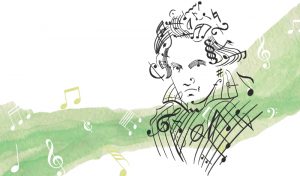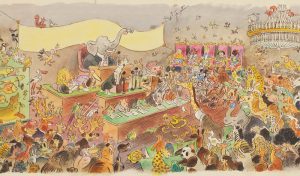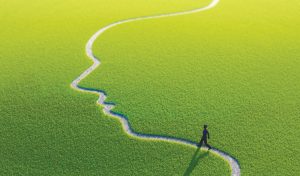The following excerpt is from Ikeda Sensei’s lecture on “On Repaying Debts of Gratitude” in his lecture series Learning from the Writings: The Hope-filled Teachings of Nichiren Daishonin, pp. 222–27.
To repay one’s debts of gratitude is the highest virtue. Neglecting gratitude is a reflection of a life controlled by innate negativity.
As we each deepen our faith in the Mystic Law, break through our fundamental darkness[1] and live true to our greater self, we will come to feel boundless appreciation for all those around us and for all who have nurtured and helped us become who we are. And we will confidently make our way along the invigorating path of recognizing and repaying our debts of gratitude.
In contrast, those who fail to refresh their faith, who give in to negativity and are shackled by attachments to the lesser self invariably become ruled by arrogance, cowardice or anger. As they descend, their ability to appreciate the goodness of others wanes until, eventually, they neither recognize nor repay the kindnesses others have done for them.
It all comes down to either living based on the greater self or remaining attached to the lesser self. Ultimately, this difference in the fundamental orientation of our attitude determines whether we will lead lives of gratitude or ingratitude.
The Lives of Genuine Buddhist Practitioners Shine With Appreciation and Gratitude
Recognizing debts of gratitude expresses the Buddhist spirit of cultivating the richest possible humanity, while repaying that gratitude is the hallmark of a life of wisdom that comes from conquering fundamental ignorance. Hence, the lives of genuine Buddhist practitioners always shine with the inner light of appreciation and gratitude.
Throughout his life, Nichiren Daishonin demonstrated an extraordinary commitment to repaying his gratitude as a human being and as a Buddhist. He writes, “Ever since I began to study the Law handed down from Shakyamuni Buddha and undertook the practice of the Buddhist teachings, I have believed it is most important to understand one’s obligations to others, and made it my first duty to repay such debts of kindness” (“Conversation between a Sage and an Unenlightened Man,” The Writings of Nichiren Daishonin, vol. 1, p. 122).
Nichiren vowed to “become the wisest person in all Japan” (“The Tripitaka Master Shan-wu-wei,” WND-1, 175) and, upon entering Seicho-ji[2] at a young age, diligently applied himself to his studies in order to repay his debt of gratitude to his mother and father. With firm conviction, Nichiren thoroughly studied the teachings of Buddhism and identified the key to solving the sufferings of birth and death, and he sought to help his parents realize true happiness.
Moreover, it was to repay his gratitude to all living beings that, after two decades of intensive Buddhist study, he established the teaching of Nam-myoho-renge-kyo and, understanding the scope of his perilous battle, he “refuted the erroneous and revealed the true”[3] in the realm of Buddhism. Discovering in the depths of the Lotus Sutra the universal Law of life for the enlightenment of all people and of all living beings, Nichiren lived as the sutra taught, embodying it in his own life.
Furthermore, because he recognized his debt of gratitude to his country, he strictly admonished various schools of Buddhism that slandered the Law and went against the Buddha’s original intent. And he remonstrated with the rulers of Japan, who stood idly by while the people suffered and the country fell into confusion and disorder.
Repaying one’s debt of gratitude to one’s country does not mean slavish submission to the ruler or the state. In modern terms, we can consider country as referring to society. Nichiren’s effort to “establish the correct teaching for the peace of the land”—bringing about the fundamental reformation needed for creating a better society—can be considered a means of repaying the debt of gratitude to the country.
After surmounting life-threatening persecutions and casting off his transient status as an ordinary person to reveal his true identity as the Buddha of the Latter Day of the Law,[4] Nichiren revealed the Gohonzon as the object of devotion and manifestation of his enlightened state of life. He also revealed and established the Three Great Secret Laws as the framework for spreading the teachings of the Lotus Sutra throughout the Latter Day. Determinedly carrying out the struggle to reveal the correct Law hidden in the depths of the Lotus Sutra that would lead all people to enlightenment, he took on the momentous battle of repaying his gratitude to the three treasures.[5]
In addition, the revelation of the Three Great Secret Laws is said to signify Nichiren fully repaying his debts of gratitude to his parents, to all living beings and to the nation, as well as marking a fresh undertaking in his life toward the realization of worldwide kosen-rufu—the means for repaying gratitude owed to humankind and the world.
We can view Nichiren’s entire life, then, as a grand endeavor to repay debts of gratitude. In this treatise, “On Repaying Debts of Gratitude,” he discusses this in detail in order to express his appreciation to his former teacher Dozen-bo.[6]
A Treatise Containing “Matters of the Utmost Importance”
In June 1276, Nichiren Daishonin received news of the death of Dozen-bo, under whom he had first studied Buddhism at Seicho-ji. He immediately set about composing this treatise in honor and appreciation of his late teacher. In late July, he sent the completed work to the priests Joken-bo and Gijo-bo[7]—who, during his early years of study under Dozen-bo, had been Nichiren’s seniors and who later became his followers. Nichiren attached a message instructing that they should have the text read aloud before Dozen-bo’s grave.
In the cover letter to “On Repaying Debts of Gratitude,” the Daishonin writes, “In the enclosed treatise, I have written matters of the utmost importance” (WND-1, 737). This writing contains a detailed description of his ardent pursuit of Buddhism in his youth, along with a comprehensive account of his subsequent efforts to spread the Mystic Law. He also clarifies the immeasurable benefits of Nam-myoho-renge-kyo of the Three Great Secret Laws, which constitutes the great Law that will lead all people to enlightenment and that is to be propagated throughout the eternal future of the Latter Day. And he pays tribute to his first teacher by stating that this benefit in its entirety will return to Dozen-bo.
This treatise can be viewed as a record of Nichiren’s lifetime struggles to refute the erroneous and reveal the true. It closes with the triumphant proclamation that the path to enlightenment in the Latter Day is open to all through the Buddhism of the Three Great Secret Laws.
The culmination of the Daishonin’s struggle to propagate the Law is the revelation of the foundation of kosen-rufu, which is Nam-myoho-renge-kyo of the Three Great Secret Laws.
The first of the Three Great Secret Laws is the object of devotion of the essential teaching. In the Gohonzon, Nichiren embodied the supremely noble life-state of his own enlightenment.
He did so in order to enable each person to become aware of this state of life that inherently and equally exists in all human beings.
The second of the Three Great Secret Laws is the daimoku of the essential teaching. This consists of our chanting Nam-myoho-renge-kyo and teaching others to do the same—Nam-myoho-renge-kyo being the name of this noble state of life, or Buddha nature.
The sanctuary of the essential teaching, the third of the Three Great Secret Laws, serves as the foundation for constructing a harmonious community of believers (Skt sangha) in which members encourage one another to maintain firm faith in Nam-myoho-renge-kyo, vow to propagate the Law and actualize the principle of establishing the correct teaching for the peace of the land.
Based on these three elements, practitioners of Nichiren Buddhism strive to realize kosen-rufu by bringing the brilliance of the infinitely precious Mystic Law to shine in people’s lives and in the land where they reside.
References
- Fundamental darkness: Also fundamental ignorance or primal ignorance. The most deeply rooted illusion inherent in life, said to give rise to all other illusions. Darkness in this sense refers to the inability to see or recognize truth, particularly, the true nature of one’s life. The term fundamental darkness is contrasted with the fundamental nature of enlightenment, which is the Buddha nature inherent in life. ↩︎
- Seicho-ji: The temple in Awa Province (present-day southern Chiba Prefecture), where Nichiren was ordained at the age of 12 and where he later proclaimed his teaching. ↩︎
- Refuting the erroneous and revealing the true: To challenge and prove false erroneous Buddhist teachings and viewpoints and bring to light the correct teachings. Nichiren Daishonin writes, “If one fails to denounce the enemies of the Lotus Sutra, it will be impossible to attain the way” (“Encouragement to a Sick Person,” WND-1, 78). He teaches that the way to attain Buddhahood in this lifetime and achieve the widespread propagation of the Law is found in the struggle to denounce falsehood and proclaim truth. ↩︎
- At the time of the Tatsunokuchi Persecution (on Sept. 12, 1271), Nichiren discarded his transient status as “an ordinary person at the stage of hearing the name and words of the truth” and revealed his true identity as “the Buddha of limitless joy who has been enlightened from time without beginning,” while remaining an ordinary person. ↩︎
- The three treasures: The three treasures in Nichiren Buddhism are the three things that all Buddhists should revere and serve. They are the Buddha, the Law (the Buddhist teachings) and the Buddhist Order (community of believers). In Sanskrit, they are known as the Buddha, Dharma and Sangha. The Buddha is one who is awakened to the truth of life and the universe. The Dharma, or Law, means the teachings that the Buddha expounds in order to lead all people to enlightenment. The Sangha, or Buddhist Order, is the group of believers that practices the Buddha’s teachings, preserves the Law, spreads it and transmits it to future generations. ↩︎
- Dozen-bo (d. 1276): A priest of Seicho-ji, a temple in Awa Province, under whom Nichiren studied from age 12. When Nichiren first declared his teaching at Seicho-ji (in 1253), his refutation of the Nembutsu teaching of the Pure Land school enraged Tojo Kagenobu, the steward of the area and an ardent Pure Land believer, who ordered his arrest. Dozen-bo helped Nichiren escape at that time, but he was nevertheless afraid to oppose Kagenobu. After the Komatsubara Persecution (in 1264), Dozen-bo sent a message to the Daishonin asking whether it was possible for him to attain Buddhahood. In response, the Daishonin issued a refutation of the Nembutsu teaching and encouraged Dozen-bo to devote himself to the correct teaching. It seems that Dozen-bo did arouse a measure of faith in Nichiren’s teaching from that time; however, he died without formally converting. ↩︎
- Joken-bo and Gijo-bo: Priests at Seicho-ji who, as disciples of Dozen-bo, had supported the Daishonin during his early studies. When the Daishonin declared the establishment of his teaching at Seicho-ji in 1253, they helped him escape when his life was threatened by the local steward, Tojo Kagenobu, who was enraged by his denunciation of the Pure Land teachings. Later, they became Nichiren’s followers and received several of his writings. ↩︎
You are reading {{ meterCount }} of {{ meterMax }} free premium articles





